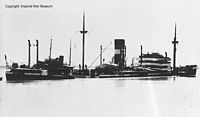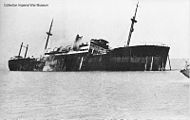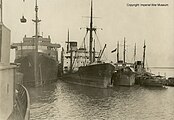Sturmfels (ship, 1921)
|
The storm rock
|
||||||||||||||||||||
|
||||||||||||||||||||
|
||||||||||||||||||||
|
||||||||||||||||||||
|
||||||||||||||||||||
The second Sturmfels of the German Steamship Company "Hansa" (DDG "Hansa"), put into service in 1921, was the type ship of the twelve Sturmfels- class cargo ships put into service from 1921 , some of which had already been ordered during the First World War . It was the largest ship class of the DDG "Hansa".
The Sturmfels sought the harbor of the war in 1939, Bandar Shapur in Iran as a refuge. She stayed there for almost two years together with four other DDG “Hansa” ships. When British troops occupied the Iranian port on August 25, 1941, the crew failed to sink the Sturmfels .
As early as 1941 she was used as a freighter as Empire Kumari on the Allied side, like four of the other DDG ships "Hansa". On August 26, 1942, the ship in a convoy was torpedoed by U 375 north of Port Said at position 31 ° 58 'N / 34 ° 21' E. A corvette took over the crew and British tugs brought the badly damaged ship into shallow water off Haifa , where it sank. In 1952 the wreck was finally demolished.
History of the ship
The first Sturmfels of 5660 BRT / 8700 tdw, delivered in 1912, had taken refuge in Massaua at the outbreak of the First World War , where it was confiscated by Italy when it entered the war. It also survived World War II and was not canceled until 1958.
The second Sturmfels of the DDG "Hansa" was launched on August 12, 1920 and was the lead ship of a total of twelve cargo ships of the Sturmfels class that were delivered to the shipping company in 1921/1922 alongside ships of the larger Frauenfels type for rebuilding their services. The Sturmfels , which was ordered in March 1916, was built by AG Weser under construction number 263, where under construction numbers 264/5 and 276–279 six other ships of this type were built, which were also ordered in 1916.
To this end, three ships were built at the Joh. C. Tecklenborg shipyard and one each at the Howaldtswerke in Kiel and the Flensburger Schiffbau-Gesellschaft . With a total of twelve ships, the type was the largest uniform series of the DDG "Hansa" between the world wars. The ships were delivered between March 1921 and December 1922.
At the same time, the four new buildings of the larger Frauenfels class were built near Tecklenborg. With these ships, the shipping company rebuilt its services to India. The new building was 131.5 m long, 17.23 m wide and had a draft of 8.04 m. The ship was measured with 6288 GRT and had a load capacity of 9367 dwt. The new building was driven by a 3-cylinder triple expansion machine made by the shipyard , which produced 3200 PSi and acted on a screw. It enabled the Sturmfels to reach a speed of 12 knots . The engine output of the ship increased to 3950 PSi in January 1936 through the installation of a Bauer-Wach exhaust steam turbine. This modernization took place on all ships at Deschimag Werk AG Weser between May 1934 and April 1936.
On March 10, 1921, the second Sturmfels was delivered to the DDG "Hansa". Eight more ships followed by the end of the year. The ships had a loading gear with a 30 t and a 20 t boom and sixteen 5 t booms. The crews should include 74 men, with eight Europeans and 39 Indians being used in the machine. All ships had cabins for four passengers.
The new Sturmfels was used on the shipping company's liner services to the Middle East. Upon receiving the warning messages about the imminent outbreak of war, the start of the war in 1939, the ship that was also on the way home in Bushir called at the Iranian Bandar Shahpur as a safe haven . The sister ship Wildenfels and the somewhat larger Marienfels were also located there . Finally, the motor ships Weissenfels (7861 BRT, 1925) and Hohenfels (7862 BRT, 1938) also arrived there. Of the nine other Sturmfels- class ships in service, three were at home when the war began. The Falkenfels was in the Mediterranean, Liebenfels and Wartenfels in the Italian Massaua on the Red Sea, the Drachenfels in the Portuguese Mormugoa and the Werdenfels in the Dutch Sabang . At sea was the Trifels , which tried to reach home around Africa, but was captured by a French auxiliary cruiser after leaving the Azores.
Fate of war
The Sturmfels and the other four DDG ships “Hansa” remained in the port of Bandar Schahpur at the end of the Persian Gulf near Basra in British Iraq until 1941 . During the times of the German-Soviet alliance, the crews of the three steamships were reduced, as these ships were not expected to be used during the war and some of the German seafarers returned home via the Soviet Union.
Of the sister ships of Sturmfels was Werdenfels on May 12, 1940 seized by the Netherlands and as Balingkar used on the Allied side.
The Wartenfels managed from Massawa to that of Vichy France -controlled Diego Suarez to escape, while the Liebenfels in Massawa be sunk before the British occupation in April 1941 itself.
After the German attack on the Soviet Union (Operation Barbarossa) in June 1941, the British feared that the Abadan refinery of the Anglo-Iranian Oil Company (AIOC) could fall into German hands despite its declared neutrality because of a pro-German stance in Iran. To this end, an easier way was sought to supply the Soviet Union with urgently needed supplies under the US law on lending and leasing . On August 16, 1941, the British and Soviet ambassadors demanded that the Iranian government expel all Germans working in Iran.
Because the latter refused, on August 25, 1941, Iran was invaded by British and Soviet troops. A small British unit of two infantry battalions landed with the auxiliary cruiser HMAS Kanimbla , the gunboat HMS Cockchafer (1915, 625 ts), the corvette HMS Snapdragon (K10, 1940, 975 ts), the trawler HMT Arthur Cavannagh and the Indian sloop HMIS Lawrence ( L83, 1919, 1225 ts) and two other auxiliary ships in the port of Bandar Shahpur to secure the port and the oil terminal. Of the German ships, the Hohenfels , sister ship of the auxiliary cruiser Atlantis and Pinguin , should be secured. The remaining German crews initiated the prepared self-sinking, which was not very successful due to the port's shallow water. The five "Hansa" ships, three Italian ships and two Iranian gunboats, a floating dock and the end of the railroad were captured.
Only the crew of the motor ship Weissenfels succeeded in destroying their ship; the others could be lifted and repaired relatively quickly. The Hohenfels came as Empire Kamal , the Marienfels came as Empire Rani , the Wildenfels came as Empire Raja and the Sturmfels came as Empire Kumari in service on the Allied side.
The end of the Empire Kumari ex Sturmfels
The Empire Kumari was operated by the Anchor Line on behalf of the Ministry of War Transport . On August 26, 1942, the Empire Kumari was torpedoed in the early evening in convoy LW 38 en route from Haifa to Port Said by the German submarine U 375 at 31 ° 58'N, 34 ° 21'E. Three men of the crew were killed. The captain, a crew of 84 and four gunners were taken over by the corvette HMS Gloxinia (K 22) and the heavily damaged ship was towed. Then the salvage tug HMS Brigand (W 83) and the port tug Roach took over the Empire Kumari , while the corvette brought the crew to Haifa. The tug reached Haifa Bay, but the former storm rock sank off the port of Haifa on the evening of August 27.
In June 1952 the wrecks were demolished.
The fate of being finally destroyed by the Germans after being captured by the Allies, also suffered
the sister ship Werdenfels as the Dutch Balingkar on August 18, 1941 by U 214,
the Uhenfels on June 27, 1941 as Empire Ability by U 69 and
the Lindenfels as Dutch Mangkali hat through a Dogger Bank mine on May 4, 1942 .
A number of ships built for the DDG "Hansa", which had been flagged under different flags during or after the First World War, were destroyed by the Germans in the Second World War.
The Sturmfels- class ships
| Surname | Shipyard | GRT tdw |
Launched in service |
further fate |
| Storm Rock (2) |
AG Weser Building No. 263 |
6288 9367 |
08/12/1920 03/10/1921 |
January 1936 Installation of the exhaust steam turbine, 1939 Bandar Schahpur, 25 August 1941 set on fire during the British invasion, repaired in 1941 as Empire Kumari , torpedoed by U 375 on August 26, 1942 and sunk off Haifa the following day |
| Lauterfels (2) | AG Weser Building No. 264 |
6310 9357 |
February 19, 1921 May 1, 1921 |
April 1935 Installation of an exhaust steam turbine, 1939 troop transport in the Baltic Sea, sunk on October 8, 1942 after being hit by a mine off Terschelling at position 53 ° 34 'N / 05 ° 05' E |
| Gutenfels (3) | AG Weser Building No. 265 |
6310 9090 |
April 8, 1921 July 2, 1921 |
on August 24, 1923 on a trip from Calcutta to Bremen with a cargo of general cargo stranded near Gibraltar and later declared a total loss |
| Falkenfels (2) | AG Weser Building No. 276 |
6318 9367 |
6.06.1921 29.10.1921 |
July 1935 installation of the steam turbine, 1939 Ancona , then Fiume , Trieste , 1940 transporter in the Mediterranean Sea, May 21, 1941 sunk in the Ionian Sea off the Greek coast after being hit by a mine; |
| Werdenfels (2) | AG Weser Building No. 277 |
6318 9367 |
June 29, 1921 December 21, 1921 |
April 1936 Installation of exhaust steam turbine, 1939 Sabang , confiscated in 1940: Balingkar , August 18, 1941 in convoy SL 118 on the journey to Great Britain north of the Azores sunk by U 214 at 41 ° 34´N, 19 ° 49´W |
| Liebenfels (2) | AG Weser Building No. 278 |
6318 9367 |
11/29/1921 02/21/1922 |
August 1935 Installation of the exhaust steam turbine, 1939 Massaua , set on fire and sunk by the crew on April 4, 1941, recovered by the British and put back into service in autumn 1942 as Empire Nile , 1948 sold to China, 1981 |
| Birkenfels (2) | AG Weser Building No. 279 |
6322 9357 |
March 7, 1922 April 23, 1922 |
May 1934 Installation of the exhaust steam turbine, intended as a transporter for the Seelöwe company in 1940, sunk off the Scheldt after being hit by a mine on December 18, 1940 |
|
Trifels (3) |
Tecklenborg building number 284 |
6182 9377 |
14.01.1921 02.23.1922 |
August 1935 installation of the exhaust steam turbine, on the way out of the Indian Ocean in 1939, marched around the Cape of Good Hope to Ponta Delgada / Azores by September 26, 1939 sailed again to break through the blockade, arrested on the 14th by the French auxiliary cruiser Koutoubia and after Brought to Casablanca , in French service as Sainte Louise , taken over again by the Germans in Bordeaux on February 18, 1941 , sunk on September 9, 1941 on a journey from there to Rotterdam off Calais by British motor torpedo boat |
| Wartenfels (2) | Tecklenborg building number 288 |
6181 9357 |
October 3, 1921 December 3, 1921 |
November 1935 Installation of the steam turbine, on the journey home in the Red Sea off Suez in 1939 , ran back to Massaua, escaped from Massaua on February 26, 1941 and escaped to Diego Suarez , repaired there in the dry dock , in the case of British occupation on May 6, 1942 by own crew machine Blown up and set on fire, repaired by the British and commissioned as Empire Tugela in November 1942 , renamed Chitpur in 1947 , sold to China in 1948, canceled in 1995 |
| Wildenfels (2) | Tecklenborg building number 311 |
6223 9479 |
October 21, 1922 December 19, 1922 |
July 1935 Installation of the exhaust steam turbine, sought refuge in Bandar Schahpur in 1939, part of the 1940 occupation via the Soviet Union back to Germany, sunk by the remaining crew on August 25, 1941 during British occupation, lifted by the British and commissioned as Empire Raja in 1941 , to China sold, 1951 resale to Japan, abandoned in 1960 as Liverpool Maru |
| Drachenfels (3) |
Howaldt building number 594 |
6342 9479 |
06.1921 13.09.1921 |
August 1935 Installation of the steam turbine, sought refuge in Mormugoa in 1939 , set on fire and sunk by the crew on March 9, 1943 after the British attack on the Ehrenfels , wreck lifted and scrapped in 1948 |
| Trautenfels (2) |
Flensburg building number 358 |
6418 9611 |
July 26, 1921 November 5, 1921 |
1939 in Germany, on September 7, 1941 together with the Barcelona (Sloman, 3101 BRT, 1921) in front of the Porsangerfjord with 1500 soldiers of the 6th Mountain Division on board an attack by the British cruisers HMS Aurora and HMS Nigeria escaped Sink the securing artillery training ship Bremse , Trautenfels sank on December 11, 1942 off Terschelling after being hit by a mine |
Web links
literature
- David Abram: Goa , Rough Guides (2003), ISBN 1-84353-081-3 , p. 177.
- Hans Georg Prager: DDG Hansa - from liner service to special shipping , Koehlers Verlagsgesellschaft, Herford 1976, ISBN = 3-7822-0105-1.
- Jürgen Rohwer, Gerhard Hümmelchen: Chronicle of the Naval War 1939-1945 , Manfred Pawlak VerlagsGmbH (Herrsching 1968), ISBN 3-88199-0097 .
- Reinhardt Schmelzkopf: The German merchant shipping 1919-1939 , Verlag Gerhard Stalling, Oldenburg, ISBN 3-7979-1847-X .








